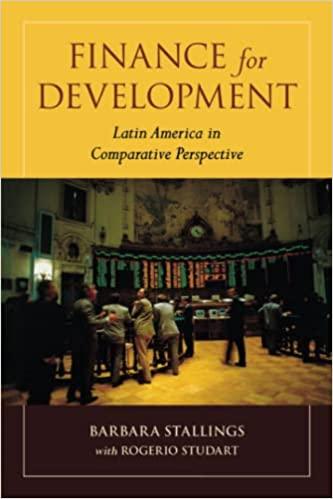Question
This past Wednesday, the first trading day of 2013, the Standard & Poor's 500 -stock index jumped 2.5% after the White House and Congress agreed
This past Wednesday, the first trading day of 2013, the Standard & Poor's 500 -stock index jumped 2.5% after the White House and Congress agreed on a new tax-and-spending package. That was its biggest daily return in nearly 13 months. Even after a tepid employment report on Friday, the S&P 500 ended the week up another 0.5%.
But investors' euphoria extends beyond U.S. blue-chip stocks. The Russell 2000 index of small stocks surpassed its all-time high this past week. On Wednesday, the yield on the Barclays U.S. Corporate High Yield Index fell below 6% for the first time ever, as investors pushed high-yield, or "junk," bonds to their highest prices on record.
And the giddiness is global. Stock markets in Argentina, China, Egypt and Finland all shot up by at least 4% in the first two trading days of 2013, largely in response to the news out of Washington. On Thursday, Banco Bilbao Vizcaya Argentaria, BBVA +4.69% a big Spanish bank, sold $2 billion in debt at a yield of just 3.8%, another sign that bond investors are willing to pay high prices in hopes of getting even a smidgen of extra return.
Starved for good news after a dozen years of bear markets and wrenching volatility, investors need to keep their expectations in check and to avoid taking unacceptable risks in the pursuit of yield.
It is especially important to recognize two related flaws of the human mind: People tend to underestimate how hard it is to earn high rates of return and how much wealth those growth rates would achieve.
A 2.5% return doesn't sound particularly hard to sustain, but if the market went up at that same daily pace each of the other 20 trading days in January, investors would earn a 65% return. A full year's worth of 2.5% daily returns would yield a return of more than 50,000%.
Because the human mind isn't very good at appreciating the power of exponential growth, thinking realistically about high returns is hard.
Consider the oft-told myth about the inventor of chess: Granted any wish by a grateful king, the inventor asked to be paid with one grain of rice on the first square of the chessboard, with the amount to be doubled on each successive square. The king casually agreed, expecting to pay out a few handfuls of rice, only to discover that by the 64th square he would owe the inventor quintillions of grainsenough to carpet the entire planet with rice pilaf.
According to recent research by economists Joshua Tasoff of Claremont Graduate University and Matthew Levy of the London School of Economics, many people believe that a one-percentage-point increase in compounding is equally valuable at all growth rates.
That probably is because compound growthin which the original amount and all additions to it grow at the same rateis rare outside the financial world. Roughly one in three people, estimate Messrs. Tasoff and Levy, are completely flummoxed by compoundingand the more severely they misunderstand it, the more confident they are that they have it right.
People with this "exponential growth bias" believe that a boost in the compound rate of return from 2% to 3% will make as big a difference in their final wealth as an increase from 12% to 13% would. No wonder so many investors are tempted to reach for yield at today's low interest rates, when little gains feel as if they mean a lot. But the math doesn't work in the real world the way it does in investors' minds. Over 10 years, $10,000 compounded at 2% amounts to $12,190; at 3%, it rises to $13,439, or $1,249 more. But the same $10,000 compounded at 12% for a decade yields $31,058; at 13%, $33,946, or $2887 more.
In short, a little bit of extra return isn't nearly as valuable in a low-rate world as people intuitively believe it to be. Some investorsforemost among them Warren Buffettfeel the power of exponential growth in their very bones. Even as a young man, according to his biographer, Alice Schroeder, Mr. Buffett developed the habit of regarding any money that he didn't invest as a reduction in the rate at which his future wealth could expand: "Do I really want to spend $300,000 for this haircut?"
But most other investors underestimate the power of compounding, according to Messrs. Tasoff and Levy. Since these people don't fully appreciate the accelerating rate at which money builds in the future, they set less money aside in the present saving about 40% less than those who are accurate in estimating compound growth.
In short, considering that just about all financial assets are at or near record highs in today's markets, the sensible thing for investors to do isn't to ratchet up their risk, trade faster or try squeezing out every last drop of yield. Instead, save more, stretch out your horizons as long as you can and let the power of compoundingeven at low ratesdo its quiet work.
According to Jason Zweig, earning a return of 2.5% per day would result in what compound return over a 20-day trading period and over a year?
Step by Step Solution
There are 3 Steps involved in it
Step: 1

Get Instant Access to Expert-Tailored Solutions
See step-by-step solutions with expert insights and AI powered tools for academic success
Step: 2

Step: 3

Ace Your Homework with AI
Get the answers you need in no time with our AI-driven, step-by-step assistance
Get Started


